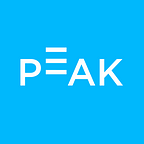Hacking brains with 12 year old Anish Singhani
Showing the rest of us how it’s done, Anish Singhani won the Peak prize (yes, an Apple Watch) for his slick integration of Must Sort with the NeuroSky
Early last month, we at Peak were lucky enough to be part of the NeuroGaming Hackathon in San Francisco, hosted by the lovely Pivotal Labs. At the forefront of the emerging NeuroGaming industry, the participants were busy with brain computer interfaces, motion and gesture control, virtual reality, and particularly in their applications to solving very real problems.
Anish grabbed our attention straight away, not least for his determination to build something meaningful on his own. On day one, he had managed to integrate the NeuroSky headset with our Game API; playing sorting game Must Sort using controlled blinking (one for left, two for right). Fully playable by the Peak team, who simply put on the headset and started tapping away, Anish’s integration was truly slick.
We caught up with Anish to hear more about how he got into this world and what’s up next for him…
Why did you decide to join the NeuroGaming Hackathon?
Anish: This year my science project was about the brain-computer interface (BCI) and brain-sensing. So while researching for my project I found out about the NeuroGaming Hackathon. I got interested as I saw this as an opportunity to meet experts from the BCI field and possibly learn more about it . I also wanted to build something cool using BCI.
How long have you been hacking BCIs?
Anish: I have been working in the BCI field for the last four months, but this was my first BCI related Hackathon.
Tell us about your winning project.
Anish: My project was a virtual keyboard which could be used by paralyzed people using their brainwaves. I used a NeuroSky brain sensor, and I created a program to detect blinks and control a virtual keyboard. By blinking, the user can select a row and then a column to choose a letter and type it, allowing users to control a keyboard and type with the blink of an eye.
At the hackathon, I learned about Peak and the Peak hackathon challenge, and decided to attempt it. I successfully created another solution, very similar to my keyboard, to control the Peak game Must Sort. The way this worked was based on the number of blinks. When a user blinks once, the frontmost object moves right, just as if the user had clicked on the right side of the screen, and if the user blinks twice quickly, the object moves left, as if the user had tapped on the left side.
Which other hackathon project were you impressed with?
All of the projects were very cool and impressive, and I enjoyed seeing the different ways people used BCIs, for many different uses. My favorite project was Controlit. The way they have used brain sensing for helping OCD is very powerful.
What is the next big thing for you?
I liked BCI so much, that I started controlling many other devices, including in my science fair project. One of the big things I controlled was a wheelchair. I created an app, which allows a user to select an option by blinking, allowing them to go forward, turn right, turn left, and stop the wheelchair. Currently I am controlling a toy wheelchair, but I will soon start working on a real wheelchair which will be controlled, possibly using OpenBCI.
I also went to another hackathon, and created a focus app based on brain sensing. The app alerts the user with a notification whenever they lose focus. I created this app for both iPhone and Android platforms. It can even alert the user on an Apple Watch. I have already published this app on Google Play for Android. This is a great app for students, professionals, drivers and other people who need to focus on a task.
How does it feel to be the youngest participant, by far?
It was an awesome experience for me. This was my first Hackathon. It was great to meet BCI experts, all the company representatives and everyone participating there. I learned so much.
What would you like to see coming from Peak?
- Something for young kids, like kids-friendly animation and some kind of game/app for them to improve their cognitive skills.
- Something for teenagers with an award system, like if they reach a certain score they could get a free Peak subscription.
- Tilt-based Peak games on phones and Apple Watch.
About Anish Anish started programming when he was in the second grade. He started with Python, and also took an interest in Robotics - building a number of robots to perform many functions. By the time he was in fourth grade, he had started making apps for Android and iOS. Initially they were just for fun (like for birthday cards and Mother’s Day). On his 10th birthday he made an app for his birthday party, and later decided to publish it on Google Play and the App Store. He has since published more apps on the Google Play Store. He also enjoys working on projects using Raspberry Pi and Arduino. He has made a working model of Bascule Bridge and a smart home system prototype using Arduino. Anish can program in Java, C++/C, Objective-C, Web/HTML/JavaScript and Python. He loves to read technical magazines like PC world, Mac world, and Popular Science, and has his own YouTube Channel — iShareTech.
